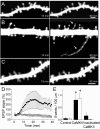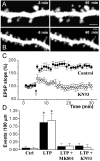Calcium/calmodulin-dependent protein kinase II contributes to activity-dependent filopodia growth and spine formation
- PMID: 14627649
- PMCID: PMC6740921
- DOI: 10.1523/JNEUROSCI.23-33-10645.2003
Calcium/calmodulin-dependent protein kinase II contributes to activity-dependent filopodia growth and spine formation
Abstract
Remodeling of synaptic networks through an activity-dependent formation or elimination of synaptic connections is believed to contribute to information processing and long-term memory. Recent work showed that enhanced synaptic activation, including induction of long-term potentiation and sensory stimulation, promote a rapid growth of dendritic filopodia and the formation of new spines or new types of synapses. Here, we investigated whether calcium/calmodulin-dependent protein kinase II (CaMKII), an enzyme implicated in the control of synaptic efficacy, also participated in these mechanisms. We show that the intracellular application of autophosphorylated CaMKII reproduced these morphological changes and triggered filopodia growth and spine formation. In addition, we find that activation of endogenous kinase through the inhibition of phosphatases or the application of calmodulin in the cell produced similar effects. Conversely, blockade of CaMKII activity prevented the synaptic enhancement, the growth of filopodia and formation of new spines triggered by LTP induction, and a short anoxia/hypoglycemia. Together, these results support the interpretation that CaMKII contributes to the control of activity-dependent structural plasticity.
Figures




References
-
- Barria A, Muller D, Derkach V, Griffith LC, Soderling TR ( 1997) Regulatory phosphorylation of AMPA-type glutamate receptors by CaM-KII during long-term potentiation. Science 276: 2042-2045. - PubMed
-
- Benke TA, Luthi A, Isaac JT, Collingridge GL ( 1998) Modulation of AMPA receptor unitary conductance by synaptic activity. Nature 393: 793-797. - PubMed
-
- Engert F, Bonhoeffer T ( 1999) Dendritic spine changes associated with hippocampal long-term synaptic plasticity. Nature 399: 66-70. - PubMed
-
- Fink CC, Bayer KU, Myers JW, Ferrell Jr JE, Schulman H, Meyer T ( 2003) Selective regulation of neurite extension and synapse formation by the beta but not the alpha isoform of CaMKII. Neuron 39: 283-297. - PubMed
Publication types
MeSH terms
Substances
LinkOut - more resources
Full Text Sources
